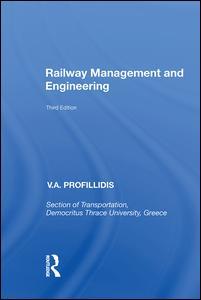Description
Railway management and engineering 3rd Ed. (3rd Ed.)
Author: Profillidis V
Language: English
Subject for Railway management and engineering 3rd Ed.:
Approximative price 154.17 €
In Print (Delivery period: 12 days).
Add to cart
Railway Management and Engineering
Publication date: 11-2017
· 15.6x23.4 cm · Hardback
Publication date: 11-2017
· 15.6x23.4 cm · Hardback
Approximative price 121.26 €
Subject to availability at the publisher.
Add to cart
Railway management and engineering 3rd Ed.
Publication date: 11-2006
· Hardback
Publication date: 11-2006
· Hardback
Description
/li>Contents
/li>
In a rapidly changing world, with increasing competition in all sectors of transportation, railways are in a period of restructuring their management and technology. New methods of organization are introduced, commercial and tariff policies change radically, a more entrepreneurial spirit is required. At the same time, new high-speed tracks are being constructed and old tracks are renewed, high-comfort rolling stock vehicles are being introduced, logistics and combined transport are being developed. Awareness of environmental issues and search for greater safety give to the railways a new role within the transportation system. Meanwhile, methods of analysis have significantly evolved, principally due to computer applications and new ways of thinking and approaching old problems. Therefore it becomes necessary to come up with a new scientific approach to tackle management and engineering aspects of railways, to understand in-depth the origins and inter-relationships of the various situations and phenomena and to suggest the appropriate methods and solutions to solve the various emerging problems. This book aims to cover the need for a new scientific approach for railways. It is written for railway managers, economists and engineers, consulting economists and engineers, students of schools of engineering, transportation and management. The book is divided into three distinct parts: Part A deals with the management of railways, Part B deals with the track and, Part C deals with rolling stock and environmental topics. Each chapter of the book contains the necessary theoretical analysis of the phenomena studied, the recommended solutions, applications, charts and design of the specific railway component. In this way, both the requirement for a theoretical analysis is met, and the need of the railway manager and engineer for tables, nomographs, regulations, etc. is satisfied. Railways in Europe have separated activities of infrastructure from those of operation. In other parts of the world, however, railways remain unified. The book addresses both situation. Railways present great differences in their technologies. Something may be valid for one such technology, but not for another. To overcome this problem, regulations of the International Union of Railways (UIC) as well as European Standardization (CEN) have been used to the greatest extent possible. Whenever a specific technology or method is presented, the limits of its application are clearly emphasized.
Railways and transport; High speeds and magnetic levitation; Policy and legislation; Forecast of rail demand; Costs and tarification; Planning and management of railways; The track system; Mechanical behaviour of track; Subgrade - geotechnical and hydrogeological analysis; The rail; Sleepers - fastenings; Ballast; Transverse effects - derailment; Track layout; Switches and crossings; Laying and maintenance of track; Slab track; Train dynamics; Rolling stock; Diesel and electric traction; Signaling - safety - Interoperability; Environmental effects of railways; List of references; Abbreviations; Index.
© 2024 LAVOISIER S.A.S.




